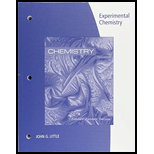
Concept explainers
Interpretation:
Ionic or covalent character of sodium hydride and the given reaction is Oxidation-reduction reaction and acid-base reactionshould be explained.
Concept introduction:
A molecule is neutral group of two or more atoms joined together by
Ionic compound is a composed of ions held together by electrostatic forces called as ionic bond. The compound is neutral, it is of consists positively charged ions called cations and negatively charged ions called anions.
Compounds of metals with nonmetals are usually called as ionic, nonmetal-nonmetal compounds are usually molecular.
The ion or molecule that accepts electrons is called the oxidizing agent and the species that donates electrons is called the reducing agent.
According to acid base theory, an acid gives the hydrogen (proton) ion and a base is accepting the hydrogen (proton).
Want to see the full answer?
Check out a sample textbook solution
Chapter 20 Solutions
Lab Manual for Zumdahl/Zumdahl/DeCoste¿s Chemistry, 10th Edition
- Give the formula for the acidic oxide of (a) HNO3 (b) HNO2 (c) H2SO4arrow_forwardThe amount of sodium hypochlorite in a bleach solution can be determined by using a given volume of bleach to oxidize excess iodide ion to iodine; ClO- is reduced to Cl-. The amount of iodine produced by the redox reaction is determined by titration with sodium thiosulfate, Na2S2O3; I2 is reduced to I-. The sodium thiosulfate is oxidized to sodium tetrathionate, Na2S4O6. In this analysis, potassium iodide was added in excess to 5.00 mL of bleach (d=1.00g/cm3) . If 25.00 mL of 0.0700 M Na2S2O3 was required to reduce all the iodine produced by the bleach back to iodide, what is the mass percent of NaClO in the bleach?arrow_forwardWhen carbon dioxide dissolves in water it reacts to produce carbonic acid, H2CO3(aq), which can ionize in two steps. H2CO3(aq)HCO3(aq)+H+(aq)Kc1=4.2107HCO3(aq)CO32(aq)+H+(aq)Kc2=4.81011 Calculate the equilibrium constant for the reaction H2CO3(aq)CO32(aq)+2H+(aq)arrow_forward
- Write two balanced chemical equations in which sulfuric acid acts as an oxidizing agent.arrow_forwardPlace the following in order of increasing acid strength. HlO < H1O 2 < HlO 3 < HlO 4; HIO 4arrow_forwardConsider the series of reactions to synthesize the alum (KAl(SO4 )2 · xH2O(s)). ) Assuming an excess of the other reagents, from one mole of sulfuric acid H2SO4 , how many moles of alum will be produced?arrow_forward
- Looking up one snowy afternoon from a book titled The Moral Case Against Turning Lead Into Gold (Or Vice Versa), your friend Lena (an expert chemist) says this: "Ammonium salts heated with aqueous hydroxides form ammonia, water, and a salt." Using Lena's statement, and what you already know about chemistry, predict the products of the following reaction. Be sure your chemical equation is balanced! NH4NO3(aq) + NaOH(aq) ->arrow_forwardWrite a balanced equation to show the reaction of aqueous aluminum acetate with aqueous ammonium phosphate to form solid aluminum phosphate and aqueous ammonium acetate. O Al(CH,O), (aq) + (NH4) PO, (ag) → AIPO, (s) + 2 NH,C2H3O3 (aq) O Al(CH,0), (aq) + (NH),PO, (aq) → AIPO, (s) + 2 NH,CH,O, (aq) • Al(CH,O), (aa) + (NH.)PO, (aq)→ AIPO, s) + 3 NH,CH,O, (aq) O Al(CO), (aq) + (NH)PO, (aq) → AIPO, (s) + 3 NH,CO, (aq) O Al(CO, (aq) + (NH,PO, (an) → AIPO, (s) + 2 NH,CO, (aq)arrow_forwardConsider the reaction: CH 4( g) + 2O 2( g) → CO 2( g) + 2H 2O( g) Which of the following statements is correct? Oxygen is the reducing agent. The reaction is not an oxidation-reduction reaction. Oxygen is oxidized. Carbon is oxidized. Carbon is the oxidizing agent.arrow_forward
- Using oxidation and reduction half-reactions, balance the skeletal equation N2H4(g) + ClO−3(aq) → NO(g) + Cl−(aq) of hydrazine with chlorate ions. The reaction takes place in basic solution. What is the smallest possible integer coefficient of ClO−3 in the balanced equation?arrow_forwardWhich do you expect to be the stronger oxidizing agent, NaBrO3 or NaClO3?arrow_forward
 Chemistry by OpenStax (2015-05-04)ChemistryISBN:9781938168390Author:Klaus Theopold, Richard H Langley, Paul Flowers, William R. Robinson, Mark BlaserPublisher:OpenStax
Chemistry by OpenStax (2015-05-04)ChemistryISBN:9781938168390Author:Klaus Theopold, Richard H Langley, Paul Flowers, William R. Robinson, Mark BlaserPublisher:OpenStax Chemistry: Principles and ReactionsChemistryISBN:9781305079373Author:William L. Masterton, Cecile N. HurleyPublisher:Cengage Learning
Chemistry: Principles and ReactionsChemistryISBN:9781305079373Author:William L. Masterton, Cecile N. HurleyPublisher:Cengage Learning Chemistry: The Molecular ScienceChemistryISBN:9781285199047Author:John W. Moore, Conrad L. StanitskiPublisher:Cengage Learning
Chemistry: The Molecular ScienceChemistryISBN:9781285199047Author:John W. Moore, Conrad L. StanitskiPublisher:Cengage Learning Chemistry & Chemical ReactivityChemistryISBN:9781337399074Author:John C. Kotz, Paul M. Treichel, John Townsend, David TreichelPublisher:Cengage Learning
Chemistry & Chemical ReactivityChemistryISBN:9781337399074Author:John C. Kotz, Paul M. Treichel, John Townsend, David TreichelPublisher:Cengage Learning Chemistry & Chemical ReactivityChemistryISBN:9781133949640Author:John C. Kotz, Paul M. Treichel, John Townsend, David TreichelPublisher:Cengage Learning
Chemistry & Chemical ReactivityChemistryISBN:9781133949640Author:John C. Kotz, Paul M. Treichel, John Townsend, David TreichelPublisher:Cengage Learning Chemistry: Principles and PracticeChemistryISBN:9780534420123Author:Daniel L. Reger, Scott R. Goode, David W. Ball, Edward MercerPublisher:Cengage Learning
Chemistry: Principles and PracticeChemistryISBN:9780534420123Author:Daniel L. Reger, Scott R. Goode, David W. Ball, Edward MercerPublisher:Cengage Learning





